Burnley Corporation Tramways
History
Burnley Corporation became a tramway owner on the 1st of March 1900, by virtue of its acquisition — together with Nelson Corporation, Padiham Urban District Council, Brierfield UDC, and Reedley Hallows Parish Council — of the standard-gauge, steam-operated Burnley and District Tramways Company. Each local authority paid a sum proportional to the tracks within its boundary, agreeing to lease operation to Burnley Corporation.
Burnley Corporation had acquired powers to purchase and run the tramway as early as 1898, expanding them in 1900 with an Act of Parliament covering conversion to overhead electric traction and municipal operation. Unusually, and with unparalleled foresight given what was to happen to many municipal tramway concerns, the corporation built a restriction into the act preventing payments to rate relief until a tramway reserve fund of £10,000 had been built up.
A decision was made to convert the steam lines to 4ft 0ins, the corporation aspiring to connect to nearby systems (i.e., Accrington, Bacup, Colne, Nelson and Rawtenstall) which either already used this gauge or intended to build tramway systems that did. Reconstruction commenced in 1901, the last steam services running on the 17th November 1901, and the first electric services commencing just over four weeks later on the 16th December. Further lines opened in 1902, 1903 and 1904, with extensions in 1910 and 1912, the last of all taking place as late as 1927 (to Brunshaw).
The BCT operated 13.05 miles of tramway, 10.35 miles owned by the corporation, 0.72 miles by Padiham UDC, 0.4 miles by Reedley Hallows UDC, 0.81 miles by Brierfield UDC and 0.77 leased from Nelson Corporation. At its maximum, Burnley Corporation Tramways operated lines: southwards to Summit; westwards to Padiham with a line branching southwestwards to Rose Grove; northwards to Nelson through Reedley and Brierfield, with a line branching northeastwards to Harle Syke; and southeastwards to Towneley with a line branching eastwards to Brunshaw. Despite its early aspirations, the BCT system was only ever connected to the tracks of Nelson Corporation Tramways, the BCT running a regular service to Nelson, leasing the last three-quarters of a mile from Nelson Corporation; Nelson Corporation Tramways cars did not venture south onto BCT tracks. At the southernmost extremity of the system — Rose Grove — the gap to Accrington Corporation Tramways was only 3 miles, but was destined never to be filled.
Like many tramway systems, Burnley's emerged from the rigours of the Great War in run-down condition with a significant backlog of repairs and renewals. Despite high costs and inflationary pressures, Burnley invested in a handful of new tramcars, whilst experimenting — from 1921 — with bus services. The latter were intended to supplement the trams, and were steadily expanded during the 1920s, no doubt helping to stave off the worst excesses of unregulated bus competition.
Whilst Burnley Corporation had seen the tramways as an essential component of an integrated transport system, a change in management in 1932 brought a 'bus man' to the helm, along with a dramatic change in policy. The tramways were suddenly considered to be old fashioned, and their abandonment was now very much on the agenda, with little consideration given to how well-maintained the system had been, how much investment had been relatively recently made, or the nature of the terrain, which was to prove challenging for the bus technology of the time. The first casualty of the new management were the Rose Grove and Harle Sykes lines, which were closed later that year.
By 1932, the corporations of Burnley, Colne and Nelson saw combined municipal operation as the way forward, something that they perhaps ought to have considered in 1901/2. On the 1st April 1933, Burnley's transport interests (including the trams) were transferred — together with those of Colne and Nelson — to the Burnley, Colne and Nelson Joint Transport Committee. Burnley were of course the major player in the BC&NJTC, and its views tended to be transposed onto the enterprise as a whole. Whilst Colne Corporation had begun abandoning its own tramway system in 1926, and had run it down considerably since then, Nelson Corporation were very much against the idea, having replaced their entire tramway fleet barely 13 years beforehand. The majority view however prevailed, Nelson being out-voted, so tram replacement proceeded across the entire concern. The last tram service of all over former BCT tracks ran on the 7th May 1935.
Uniforms
Burnley Corporation ran steam tram services for approximately 20 months following municipalisation of the former Burnley and District Tramways Company. Photographic evidence is inconclusive, but that which does survive suggests that the corporation did not bother issuing uniforms to staff working these services, instead allowing them to wear railway footplate-like attire (drivers and firemen) or informal clothing (conductors) (see link).
Conductors and motormen working the new electric services were issued with double-breasted jackets with five pairs of brass buttons (carrying the full system title and civic arms — see link), three waist-level pockets (with flaps), an open breast pocket, and lapels. The jackets were identical in style to those worn by their predecessors working for the erstwhile Burnley and District Tramways Company (see link). The bearer's left-hand collar carried an embroidered badge of some description, very likely the grade: 'DRIVER' or 'CONDUCTOR'. These appear however, to have been quickly superseded by brass, script-lettering grade badges and employee numbers — 'Driver' or 'Conductor' — each worn on both collars, a somewhat crowded badge arrangement. Occasional photos show tramwaymen with their jackets unbuttoned, revealing that a waistcoat with six buttons was sometimes worn underneath.
Unusually for a British tramway system, caps issued to motormen and conductors were markedly different in style, conductors wearing squat kepis and motormen wearing tensioned-crown peaked caps; both carried a round cap badge comprising the full system title around a municipal device (see below).
Uniform jackets appear to have remained unchanged stylistically for the entire existence of the tramway, bar minor alterations to the cut; conductors' kepi-style caps were however phased out after the Great War. Later photographs show some staff wearing a chevron(s) on their right sleeve (on an arm band), this probably denoted either long service or good conduct.
Motormen and conductors were also issued with long, double-breasted greatcoats with five pairs of buttons and high fold-over collars; it is unclear if the latter carried any kind of insignia.
Inspectors wore single-breasted jackets without buttons (more than likely a hook and eye arrangement) and stand-up collars; the latter bore the designation 'Inspector' in embroidered script lettering on a cloth badge in the shape of a scroll. The peaked caps were of the tensioned-crown variety (at least in later years) with a cloth cap badge; this bore embroidered 'B.C.T.' initials above 'Inspector', all within a wreath.
Female staff were very likely employed during the Great War to replace men lost to the armed services; however, I have yet to see a photograph, so details of the uniforms worn are currently unknown.
Further reading
For a history of Burnley transport, see: 'Burnley, Colne and Nelson Joint Transport' by A Catlow; Wyvern Publications (1984).
Images
Motormen and conductors
Tramcar staff, fitters and a man who is in all probability a council luminary, pose with Tramcar No 43 in a depot yard — photo undated, but very possibly taken in 1903 when No 43 was delivered, as it certainly looks to be in pristine condition. With thanks to the National Tramway Museum. 
A blow-up of the above photo showing the tramcar staff. The jackets are virtually identical to those worn by conductors of the BCT's predecessor, the erstwhile Burnley and District Tramways Company.
No 43's immediate predecessor (numerically), at what is believed to be the original Towneley terminus at Park Gates on Todmorden Rd — photo undated, though probably taken in 1903 given the unblemished condition of the vehicle. With thanks to the National Tramway Museum. 
A blow-up of the above photo showing the conductor. Further magnification suggests that the collars bore embroidered insignia, possibly the bearer's grade. The round cap badge, which bore the full system title and municipal arms (see below), stands out due to the strong reflection.
Burnley Corporation Tramways cap badge — brass. Author's Collection.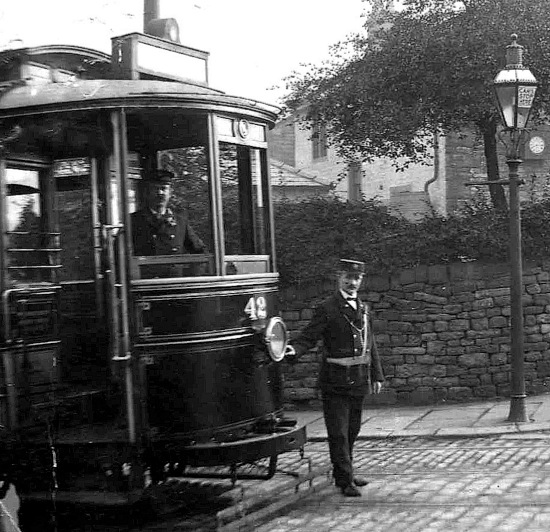
Motorman and conductor with what looks to be a fairly new Tramcar No 42 at Towneley Park Gates — photo undated, but probably taken in 1903 or 1904. Consistent with the previous photo, the motorman is wearing a tensioned-crown peaked cap, whilst the conductor wears a more old-fashioned kepi. With thanks to Duncan Holden.
Two crews pose with Tramcar No 15 on a service to Nelson — photo undated, but probably taken in the early Edwardian era. With thanks to Jim Halsall.
A blow-up of the above photo. The motormen are once again wearing tensioned-crown peaked caps, whilst the conductors are wearing kepis. The two figures on the right appear to be wearing uniform waistcoats.
Tramcar No 43 again, this time at the top of Manchester Rd in Burnley — photo undated, but certainly taken between 1910 and 1914. Photo courtesy of the Duncan Holden Collection.
A staff photo taken at what is believed to be Queensgate depot around 1914. Author's Collection.
An enlargement of the above photo showing three motormen (in tensioned-crown peaked caps) and a conductor (in a kepi-style cap). All have metal, script-lettering grade badges on their collars, 'Driver' and 'Conductor'.
The crew of Tramcar No 20 stand with their charge circa 1914 at what is possibly the Rose Grove terminus. Author's Collection.
An enlargement of the above photo showing the conductor and motorman.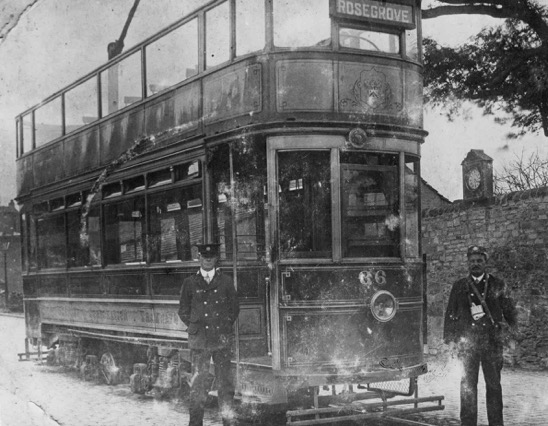
A motorman and conductor pose with Tramcar No 36 on a service for Rose Grove — photo undated, but probably taken around the time of the Great War, as this car was top covered sometime between 1914 and 1920 (it is in open-topped condition in this photo). Author's Collection.
A blow up of the above photo showing details of the motorman's uniform.
A motorman and conductor pose with Tramcar No 36, this time with a service for Harle Syke and in top-covered condition, so the photo is definitely post 1914, and very probably post Great War. The conductor is still wearing what was, by this time, a very old fashioned kepi-style cap. With thanks to Jim Halsall.
A conductor and motorman with what is possibly Tramcar No 56 — photo undated, but probably taken in the mid-to-late 1920s. Author's Collection.
A group of tramway staff, including an inspector — photo undated, but probably taken in the 1920s. Note the stripes on the sleeves of the two individuals on the left, probably denoting either long service or good conduct. With thanks to Duncan Holden.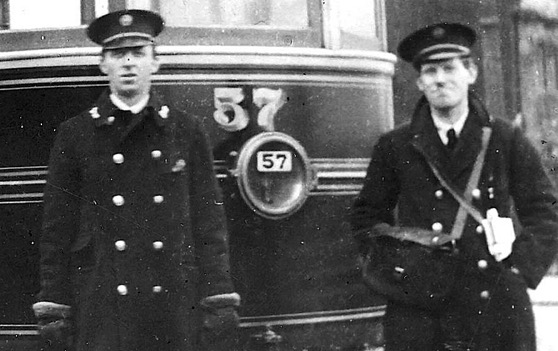
A motorman and conductor pose with Tramcar No 57 — photo undated, but probably taken in the late 1920s or early 1930s. With thanks to Duncan Holden.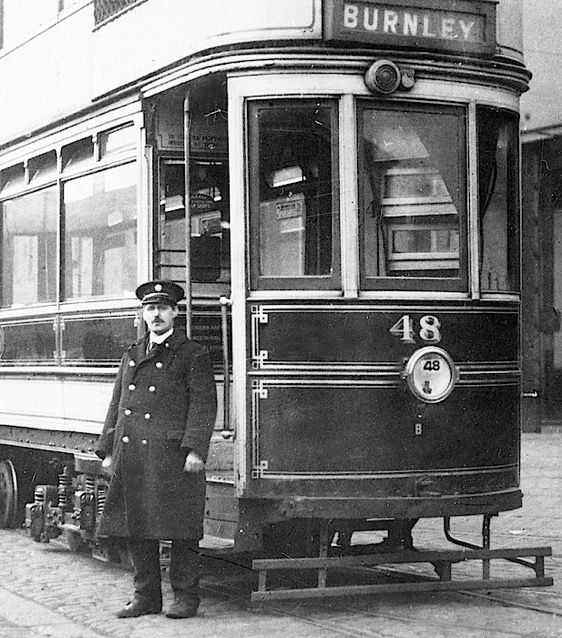
A motorman with Tramcar No 48 outside the depot — photo undated, but given that there is a 'B' below the headlamp, denoting 'Burnley', it was almost certainly taken after the formation of the Burnley, Colne and Nelson Joint Transport Committee, which took place on the 1st April 1933. The uniform and cap badge are BCT issues. With thanks to the National Tramway Museum.
Senior staff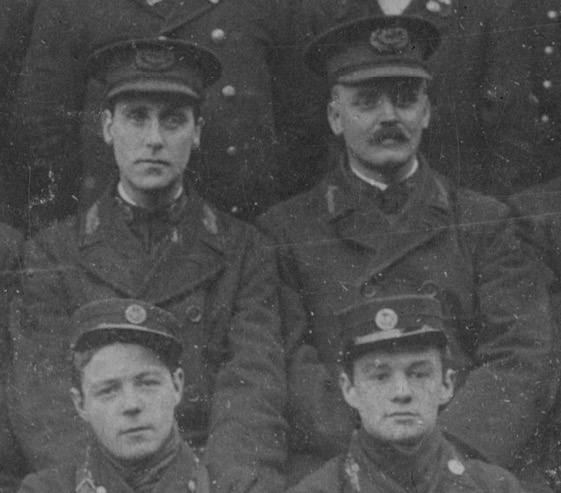
A blow-up of the circa 1914 Queensgate depot photograph above showing two inspectors (back) and two conductors (front). The inspectors' overcoat collars bear the grade (in embroidered script lettering), whilst their tensioned-crown peaked caps bear oval cloth cap badges with system initials and the grade, all within a wreath. The stand-up collars of their jackets bear embroidered grade badges in the shape of a scroll.
A blow-up of the 1920s group photo above showing the inspector on the right. The cap badge is embroidered cloth, bearing 'B C T' initials above 'Inspector', all within a wreath — the same pattern was also used by the system's successor, the Burnley, Colne and Nelson Joint Transport Committee (see link). With thanks to Duncan Holden.